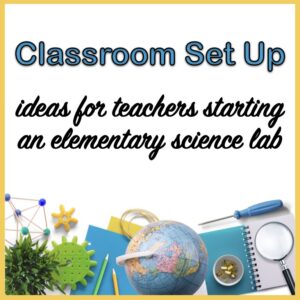How To Get Started with Classroom Setup
When something is new to you, what do you do? You look to others! Fortunately, when given the opportunity to go from a classroom to the first science and STEM teacher in our building, I had help nearby! My husband was a middle school science teacher. I picked his brain for ideas to help get started setting up a science lab. So, now let me share some valuable classroom setup tips with you!
What Science Equipment Will I Need?
A science lab has special considerations for classroom setup. Since I taught for many years, “What science equipment will I need?” was the first question I had. I view equipment as the non-consumable things that you will need year after year. Before ordering equipment, check with other teachers and the school custodian. They can probably give you some of the things you need. Ask the school librarian if funds are available for purchasing science books. Click here to get the two-page list of science equipment you need.
What Materials Will I Need?
To me, the materials are the consumable supplies that you need to replenish. Click here to get the list. Sometimes, families are willing to donate some of the items. On the night of open house, I tape construction paper magnifying glasses on my bulletin board, each with the name of a supply on it. I post a sign that reads, “Please take a magnifying glass or two if you’re able to donate supplies to our lab.”
Room Arrangement
When you are setting up a science lab, you need to give consideration to the room arrangement. Many science standards ask students to show what they learned by completing a project. Often, these are STEM activities. Science and STEM both require experimentation and collaboration. Therefore, the classroom setup should allow for this. Thought needs to given to movement and flow in the room too. After some trial and error, I found an ideal arrangement for my classroom.
The rug serves as the whole group meeting area. Tables are easy to move off to the side if you are doing an activity that requires a lot of space or push together if working in larger groups. A bin of supplies is kept on each table (pencils, crayons, scissors, and glue sticks). Furthermore, label each with a number. Then, groups are called by table number to share out. In the meantime, give thought to where your technology storage area, science library, and shelving and storage for materials. You also need access to outlets for technology, microscopes, etc. The school custodians can help you with this.
Here is a link to a post Amazing STEM Classrooms that Inspire. It has photos of some great classrooms and will truly inspire you!
Check out our STEAM Lab starter kit. Resources in this bundle will be great for your science lab too! “This is a great starter kit for anyone starting with a stem lab or maker space. All kinds of amazing ideas.”
You might also enjoy reading about procedural and behavioral expectations in the science lab.
If you found this helpful, subscribe to our blog. You will get our first 5 Science Snippets for free! Each Snippet gives an everyday application of science that you can share with your students!
And remember, it’s all science!








2 Comments
Great ideas for setting up a science Lab! Thanks Sarah!
So happy to help, Cheryl!